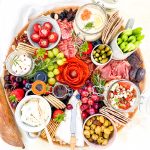
Grazing Platter
A heady combination of cold meats, cheese, nuts, dried fruits, fresh fruit and vegetables, crackers and, if you like, some fish and other delicious cold nibbles and crudités.
Ingredients
Use your choice of ingredients - this is just a guide. I used -
- Feta Cheese and Semi Dried Tomatoes Marinated in Olive Oil, Chilli, Garlic, and Fresh Oregano
- Smoked Salmon Dip with Horseradish, Lemon and Dill
- Goats Cheese Balls with Rosemary and Chilli Honey and Fresh Cherries.
- 200g wedge of Brie
- 150g gorgonzola
- 100g thinly sliced Milano salami
- 100g thinly sliced chorizo
- 100g San Daniele Ham
- small pot of truffle honey
- small pot of fig jam
- 100g tuna filled small peppers (from my local deli)
- 150g olives
- 75g small gherkins
- 100g pecan nuts
- 100g Marcona almonds
- 100g large dried raisins
- 100g Mejdool dates
- 50g fresh celery
- 200g fresh strawberries
- 200g fresh cherries
- 100g fresh blueberries
- 400g red and green grapes
- 100g crackers
- 150g oatcakes
- fresh bread - I used a baguette
Instructions
-
Collect together your equipment (see Recipe Notes below) and ingredients.
-
Place the larger items on the platter first. I was using a wooden platter. To avoid any fat/cheese being absorbed, I lined it with some baking parchment. This is optional. To start with I added the:
- Feta Cheese and Semi Dried Tomatoes Marinated in Olive Oil, Chilli, Garlic, and Fresh Oregano
- Smoked Salmon Dip with Horseradish, Lemon and Dill
- Goats Cheese Balls with Rosemary and Chilli Honey and Fresh Cherries
- pot of gorgonzola
- truffle honey
- fig jam
- tuna filled small peppers (from my local deli)
- olives
-
Make a chorizo rose – layer and build up the slices of chorizo/salami around the top of a wine glass. Invert and you will have an amazing salami rose.
-
I placed the rose in the centre of the board and then added the:
- folded Italian salami
- strips of San Daniele ham
- celery, next to the Smoked Salmon dip
- a bowl ready for the gherkins
- cherries next to the goats cheese,
- gorgonzola
-
I then removed the wrapping from the Brie, added different crackers around the board and transferred the fig jam into a smaller pot.
-
I finished the board by adding the gherkins to the bowl and filling the gaps with:
– grapes - snipped into mini bunches of 4 – 6 grapes each
- strawberries
- blueberries
- pecan nuts
- Marcona almonds
- Mejdool dates
- large raisins
- I also added some fresh rosemary to add some colour and a delicious smell.
Recipe Notes
Equipment:
- chopping board and knife
- kitchen scales and measuring spoons
- large platter
- collection of small bowl
- serving knives and spoons
What to put on a Grazing Platter
Grazing Platters can include:
- a combination of meat, fish and cheese, or
- a combination of different cheese, or
- a selection of different fish/shellfish
- a variety of different meats
- strictly vegan
Common additional ingredients alongside can include:
- fresh and/or dried fruit
- fresh and/or cooked vegetables
- crackers and breads
- nuts
- nibbles
Tips on assembling a Grazing Platter:
As everybody should help themselves, the food is intended to be finger food or food which can be easily cut or sliced; it is important to remember this when deciding what to serve. A few tips to remember:
- Ideally use a platter which is built up a little on the edges. If you don’t have one, this is not a problem but be very careful when moving it!
- Make sure the food is easy to remove from the board. For example:
- separate slices of meat and fold them so they can be removed easily.
- bunches of grapes – snip into mini bunches of 4 – 6 grapes each. You can still pile them together on the tray but small bunches are easier to remove without leaving the platter in a muddle.
- if food needs to be sliced or cut into pieces, provide knives or spoons to do this
- serve food that is likely to be a bit messy in a dish or jar on the platter – such as anything drizzled in honey or olive oil. This will also prevent any oils or honey getting on to other food and ruining it – such as making crackers soggy.
- equally, you may wish to put any food with particularly strong flavours in a separate bowl.
- Put foods which are good to eat together, next to each other. For example, I put Truffle Honey next to the Brie, the cherries next to the goats cheese, the gherkins next to the cold meats and so on. I also interspersed the crackers around the board placing them next to the food, they work the best with.
- Place large items on the platter first, saving the smallest items to last. These can then be used to fill the gaps. Small bunches of fresh herbs can also be used to fill in any gaps and add colour. Grazing platters are typically served absolutely brimming with a delicious selection of food.